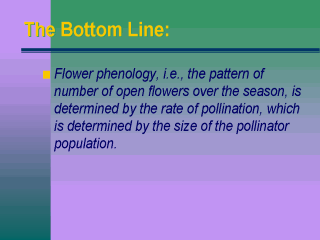Click any image in the slide to see a larger version. Scroll down to read accompanying notes. |
 |
Slide 8 of 21
Click any image in the slide to see a larger version. Scroll down to read accompanying notes. |
 |
Slide 8 of 21
![]()
To see the data and model that led to this conclusion, go on to the next
slide.
Skip the data and model and read more conclusions.
Go directly to "A test to determine if
you have enough bees in your field"
Alfalfa is an indeterminate bloomer, i.e., it continues to bloom as long as conditions are appropriate and the fruits do not mature. Read about the implications of indeterminate blooming in my essay Squash, Beans, and Deadheading Flowers.